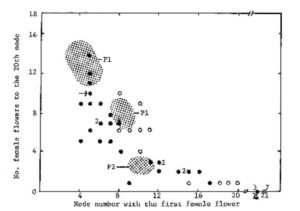Cucurbit Genetics Cooperative Report 8:78-79 (Article 30) 1985
Kwack, Soo Nyeon and Kunimitsu Fujieda
University Farm, Faculty of Agriculture, Kyushu University, Kasuyamachi, Fukuoka, Japan.
The genetic variation available in C. maxima appears insufficient for high femaleness in sex expression. Interspecific crosses have been shown to increase genetic variation in Cucurbita (3). Crosses of C. pepo with C. maxima display reduced compatibility in comparison to crosses between C. moschata and C. maxima. The development of PM lines has successfully combined the high femaleness of C. pepo with superior flesh quality of C. moschata (1). In 1983 we initiated a program to develop C. maxima germplasm with a high female/male flower ratio.
The line, ‘PM 143’, that resembles C. moschata in most characteristics, was crossed with the pollen parent, C. maxima cv. ‘Kuri’ or ‘Ebisu’ which is a typical cultivar in Japan. ‘PM 143’ X ‘Kuri’ cross produced a few seeds with fully developed embryos, while the ‘PM 143’ X ‘Ebisu’ cross yielded no viable seeds. Fluorescence microscopic observations on pollen tube growth showed that pollen tubes of ‘Kuri’ penetrate deeper into the styler canal than those of ‘Ebisu’. A backcross breeding method was applied to combine the high femaleness of ‘PM 143’ with the flesh quality of ‘Kuri’.
The hybrids obtained were intermediate to their parents in characteristics of fruit and leaf shape. The leaves of all F1 hybrids were mottled. The mottled leaves of ‘PM 143’ appear dominant to the non-mottled leaf characteristic of ‘Kuri’. The F1 hybrids were quite different from their parents in sex expression. They bore their first female flowers at lower nodes with more female flowers to the 20th node than their parents (Figure 1). These results are consistent with a previous report (2). Normal-appearing male flowers had reduced amounts of normal pollen, so F2 plants were not obtained. When backcrossed with ‘Kuri’, the hybrids produced about 30 seeds with fully developed embryos. Segregates in the BC1 population are likely to differ from their parents in sex expression. In the BC2 population, a few segregates had high femaleness although cultivated under long day and high temperature conditions. These results indicate that high femaleness may be dominant to low femaleness in this species cross.
In the BC2, we selected a few plants having a high female/male flower ratio, with a promising fruit shape, and have selfed them. New lines through interspecific hybridization are expected.

Figure 1. Relationship between node number with the first female flower and the number of female flowers to the 20th node in the parents, F1, BC1 and BC2. Dotted areas represent the distribution areas of P1, P2, or F1. P1, ‘PM 143’; P2, ‘Kuri’; F1, P1 X P2; * , BC1 (F1 X P2); * , BC2 (Bc1 X P2); selected plant for BC2.
Literature Cited
- Kim, B. H. and Y. G. Seo. 1976. Studies on the interspecific hybrids of
Cucurbita (II). Breeding process and characteristics of Bulam
Sacheol Aehobak. Jour. Kor. Soc. Hort. Sci. 17(1):38-46 (with English summary) - Robinson, R. W., M. A. Boettger and J. W. Shail. 1978. Gynoecious sex expression in Cucurbita resulting from an interspecific cross. Cucurbit Genetics Cooperative 1:31-33
- Whitaker, T. W. and G. N. Davis. 1962. Cucurbits. Leonard Hill Books Ltd., London. 250pp